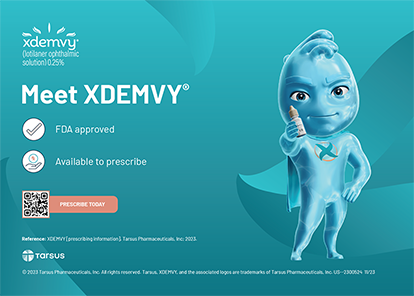
Refractive cataract surgeons get great satisfaction from providing patients with crisp, clear vision and subsequently improving their quality of life. Delaying a patient’s surgery is never welcome, but it can be crucial to lay the best foundation possible in order to maximize visual outcomes. Ocular surface disease (OSD), most commonly dry eye disease (DED), makes it challenging to obtain the accurate refractive measurements needed to create an effective, on-target treatment plan. Additionally, preexisting DED that reduces the quality of vision is often exacerbated by cataract surgery, which can leave patients with vision and symptoms that are worse than before the procedure. That is a recipe for unhappiness—for patients and for surgeons.
The development of evidence-based algorithms and advanced diagnostic tools make it simpler to diagnose and treat OSD before the cataract procedure. In doing so, physicians can dramatically improve patients’ visual outcomes and postoperative satisfaction.
PREVALENCE
The incidence of DED and OSD in asymptomatic patients presenting for cataract surgery is higher than was once assumed. In the Prospective Health Assessment of Cataract Patients’ Ocular Surface (PHACO) study, Trattler et al assessed the incidence and severity of DED in cataract patients.1 One hundred thirty-six patients completed questionnaires for the study; 86% reported feeling no symptoms of ocular dryness, and 58.8% reported experiencing no foreign body sensation. However, tear breakup time was 5 seconds or less in 62.9% of 272 eyes, corneal staining with fluorescein was positive in 77% of eyes, and the Schirmer test measured 10 mm or less in 18% of eyes.
Colleagues from Weill Cornell Medicine in New York and I collaborated on a study with similar results.2 We found a high prevalence of ocular surface dysfunction that was frequently undiagnosed and that was often present in asymptomatic patients. Of 120 patients who presented for cataract surgery, tear osmolarity and matrix metalloproteinase 9 (MMP-9) results were abnormal in 56.7% and 63.3%, respectively. Furthermore, the results were abnormal for at least one of the two tests in 85% of the patients who were asymptomatic.
VISUALLY SIGNIFICANT OSD
There has been an explosion in the number of point-of-care diagnostic tools available, and this has produced confusion among physicians. In an annual clinical survey of its membership by the ASCRS,3 more than 75% of respondents were unfamiliar with the recommendations of the Tear Film & Ocular Surface Society Dry Eye WorkShop II (better known as TFOS DEWS II)4 and the Delphi Panel International Task Force.5 Furthermore, only 9% of respondents stated that they were using tear osmolarity, and just 5% were using MMP-9 testing, even though 91% reported a belief that mild to moderate DED has an impact on patient satisfaction after cataract and refractive surgery. To address these gaps, my colleagues and I on the ASCRS Cornea Clinical Committee set about creating a consensus-based, practical diagnostic OSD algorithm to act as a streamlined tool for surgeons to diagnose and treat visually significant OSD before surgery.3
For our algorithm, we introduced new terminology for classifying OSD into two presurgical categories: nonvisually significant OSD (NVS-OSD) and visually significant OSD (VS-OSD). Although we believe it is important to identify and address all subtypes of OSD, not every subtype requires delaying refractive measurements and surgery. We therefore wanted to limit advice to postpone a planned intervention to patients whose OSD is likely to lead to adverse postoperative outcomes. NVS-OSD can include early, preclinical, or situational DED; mild conjunctivochalasis with a normal tear film; and early meibomian gland disease. As a caveat, patients diagnosed with NVS-OSD should be counselled about their condition and the potential for it to worsen after surgery. Prophylactic treatment is required before and after surgery in this group to minimize the risk of exacerbation.
SUMMARY OF THE ALGORITHM
The ASCRS-Modified Preoperative OSD Standardized Patient Evaluation of Eye Dryness II questionnaire is a unique feature of our algorithm. We designed it specifically for preoperative cataract surgery patients and adapted items from the Cataract and Refractive Lens Exchange Questionnaire developed by Steven J. Dell, MD, to address patient expectations in the setting of paying out of pocket for premium technology.6 From there, the ASCRS algorithm incorporates two noninvasive and objective point-of-care tests: tear osmolarity and MMP-9.
Tear hyperosmolarity is central to the definition of DED,7 and it is a biomarker of ocular surface health.8 Osmolarity has a high sensitivity for identifying DED.7,8 A threshold of 307 mOsm/L differentiates healthy patients from those with DED; an intereye difference of 8 mOsm/L or higher is also considered abnormal.
The enzyme MMP-9 indicates a breakdown of the ocular surface,9 and a positive MMP-9 test reading is indicated by an MMP-9 level of 40 ng/mL or higher.9 Patients with inflammation usually benefit from preoperative treatment with a topical antiinflammatory agent such as a corticosteroid, lifitegrast ophthalmic solution 5% (Xiidra, Novartis), or cyclosporine ophthalmic emulsion 0.05% (Restasis, Allergan).
Used in combination, tear osmolarity and MMP-9 point-of-care tests provide a high positive predictive value of OSD and offer clinicians insight into the health of a patient’s ocular surface. These tests are technician driven, readily available, and easily integrated into everyday practice.
For a quick, focused ocular surface examination to confirm the subtype, severity, and visual significance of OSD, we coined the mnemonic look, lift, pull, push.
Look. Look at the patient’s blink quality and quantity; examine the eyelids for malposition, lagophthalmos, proptosis and exposure, entropion or ectropion, and trichiasis; and visually assess the tear meniscus height. Look for signs of anterior and posterior blepharitis, and look at the interpalpebral ocular surface and the interpalpebral cornea.
Lift and pull. Lifting up and then pulling out the upper eyelid can help to detect superior limbal keratitis and superior corneal scars, to rule out superior epithelial basement membrane dystrophy, and to identify eyelid laxity and floppy eyelid syndrome.
Push. Pushing on the lower lid margin expresses the meibomian glands, which can be particularly helpful in identifying patients with nonobvious meibomian gland dysfunction.
TREATMENT AND PREPARATION FOR SURGERY
If a patient has VS-OSD, preoperative measurements and cataract surgery should be postponed until the corneal surface is sufficiently healthy (ie, converted to NVS-OSD). If a patient has NVS-OSD, cataract surgery may proceed as usual, with proper preoperative education and the setting of realistic expectations, as mentioned previously.
Getting patients to surgery quickly requires an aggressive approach and the use of a combination of treatments. In the ASCRS algorithm, we advise beginning at step 2 or later of the TFOS DEWS II treatment guidelines.10 Interventions are based on disease subtype and severity.
I typically instruct patients to begin administering topical steroids if they have signs of corneal breakdown, and I have an extremely low threshold for adding drugs like lifitegrast to address chronic surface inflammation. When a patient has meibomian gland dysfunction, I offer an in-office treatment such as LipiFlow (Johnson & Johnson Vision), iLux (Alcon), or TearCare (Sight Sciences) to improve meibomian gland health rapidly.
CONCLUSION
DED is a multifactorial disease that involves tear composition, ocular surface inflammation, and lid margin disease. Because of the variety of mechanisms at work, a multifactorial strategy is required to achieve a healthy corneal surface that will allow accurate preoperative measurements and successful cataract surgery.
The postponement of a planned surgery is never welcome, but it is necessary for patients with VS-OSD to ensure that the expected outcomes are achieved.
1. Trattler WB, Majmudar PA, Donnenfeld ED, McDonald MB, Stonecipher KG, Goldberg DF. The Prospective Health Assessment of Cataract Patients’ Ocular Surface (PHACO) study: the effect of dry eye. Clin Ophthalmol. 2017;11:1423-1430.
2. Gupta PK, Drinkwater OJ, VanDusen KW, Brissette AR, Starr CE. Prevalence of ocular surface dysfunction in patients presenting for cataract surgery. J Cataract Refract Surg. 2018;44(9):1090-1096.
3. Starr CE, Gupta PK, Farid M, et al; ASCRS Cornea Clinical Committee. An algorithm for the preoperative diagnosis and treatment of ocular surface disorders. J Cataract Refract Surg. 2019;45(5):669-684.
4. Gomes JAP, Azar DT, Baudouin C, et al. TFOS DEWS II iatrogenic report. Ocul Surf. 2017;15(3):511-538.
5. Behrens A, Doyle JJ, Stern L, et al; Dysfunctional Tear Syndrome Study Group. Dysfunctional tear syndrome: a Delphi approach to treatment recommendations. Cornea. 2006;25(8):900-907.
6. Dell Cataract and Refractive Lens Questionnaire. Cataract & Refractive Surgery Today. Accessed January 11, 2021. https://crstoday.com/resources
7. The definition and classification of dry eye disease: report of the Definition and Classification Subcommittee of the International Dry Eye WorkShop (2007). Ocul Surf. 2007;5(2):75-92.
8. Lemp MA, Bron AJ, Baudouin C, et al. Tear osmolarity in the diagnosis and management of dry eye disease. Am J Ophthalmol. 2011;151(5):792-798.e1.
9. Sambursky R, Davitt WF III, Latkany R, et al. Sensitivity and specificity of a point-of-care matrix metalloproteinase 9 immunoassay for diagnosing inflammation related to dry eye. JAMA Ophthalmol. 2013;131(1):24-28.
10. Craig JP, Nelson JD, Azar DT, et al. TFOS DEWS II report executive summary. Ocul Surf. 2017;15(4):802-812.




